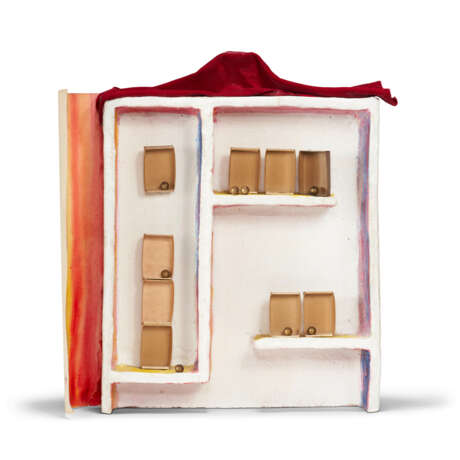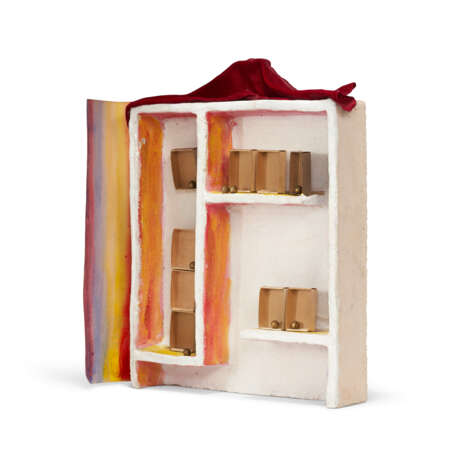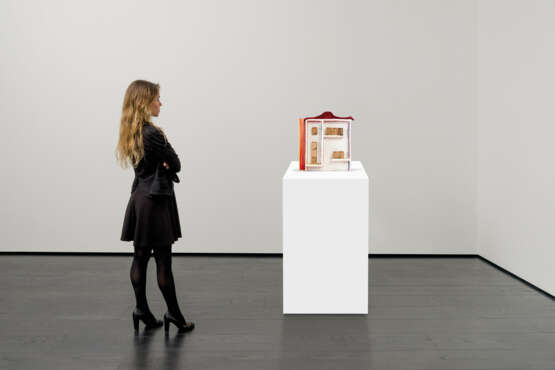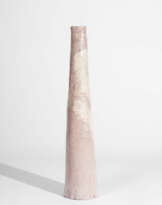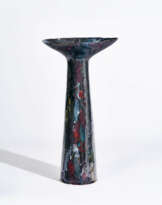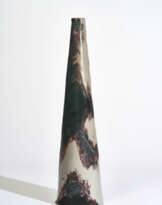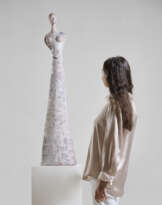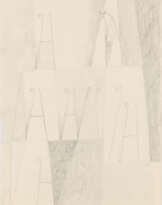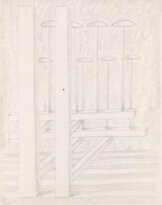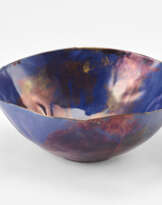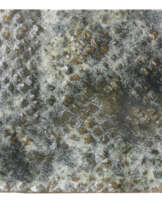ID 832071
Lot 24 | Fausto Melotti (1901-1986)
Estimate value
€ 200 000 – 300 000
L'arcobaleno in casa
signé 'Melotti' (au dos)
terre cuite et papier peints, tissu et laiton
41.5 x 37.5 x 10 cm.
Exécuté en 1978
signed 'Melotti' (on the reverse)
painted terracotta and paper, fabric and brass
16 3/8 x 14 1/2 x 3 7/8 in.
Executed in 1978
Provenance
Collection particulière, Milan.
Galerie Karsten Greve, Saint-Moritz.
Acquis auprès de celle-ci par le propriétaire actuel en 2013.
Literature
G. Celant, Melotti, Catalogo generale, Sculture 1973-1986 e Bassorilievi, Tomo secondo, Milan, 1994, no. 1978 5 (illustré en couleurs, pp. 480-481).
A. Masoero, Klee e Melotti allo specchio, in "Il Sole 24Ore", Milan, 19 mai 2013 (illustré, p. 50).
www.fondazionefaustomelotti.org (illustré).
Exhibited
Bologne, San Luca Galleria, Fausto Melotti, novembre 1986-janvier 1987.
Vérone, Galleria Dello Scudo, Fausto Melotti, Teatrini 1931-1985, décembre 1996-février 1997, no. 50 (exposé et illustré au catalogue d'exposition, pp. 148-149).
Rome, Studio Casoli, Tocco ferro, Accarezzo Roma, novembre 1997-janvier 1998.
Hornu, Le MAC's Grand-Hornu, Musée des Arts Contemporains, Fausto Melotti, mars-mai 2004.
Naples, Museo d'Arte Contemporanea Donnaregina, Melotti, décembre 2011-avril 2012, no. 436 (exposé et illustré au catalogue d'exposition, pp. 328, 378).
Lugano, Museo d'Arte Città di Lugano, Klee-Melotti, mars-juin 2013, no. 105 (exposé et illustré en couleurs au catalogue d'exposition, pp. 261, 370).
Paris, Galerie Karsten Greve, Il mondo di Fausto Melotti, février-avril 2014 (exposé et illustré en couleurs au catalogue d'exposition, pp. 40-41, 81, 233).
Special notice
Artist's Resale Right ("droit de Suite").
If the Artist's Resale Right Regulations 2006 apply to this lot, the buyer also agrees to pay us an amount equal to the resale royalty provided for in those Regulations, and we undertake to the buyer to pay such amount to the artist's collection agent.
ƒ: In addition to the regular Buyer’s premium, a commission of 5.5%
inclusive of VAT of the hammer price will be charged to the buyer.
It will be refunded to the Buyer upon proof of export of the lot
outside the European Union within the legal time limit.
(Please refer to section VAT refunds)
Post lot text
« L'esprit de l'œuvre d'art, comme l'âme humaine, est indéfnissable ». - Fausto Melotti
Composé de terre cuite peinte, de papier, de tissu et de cuivre, L'Arcobaleno in Casa («l'arc-en-ciel à la maison») (1978) témoigne de tout l'intérêt que Fausto Melotti porte à la nature, au rythme et à la musicalité. Dans un contexte d'après-guerre où son contemporain Alberto Giacometti produit des figures austères aux accents existentialistes, Melotti se sert au contraire de la vivacité de l'arc-en-ciel pour évoquer, semble-t-il, l'espoir et le renouveau. Dans l'enceinte de cette maison, des boîtes contenant de délicates billes dorées en cuivre ont été disposées sur des plate-formes, à la manière d'une suite de notes de musique sur une partition. Conçue avec des matériaux d'une grande délicatesse, cette symphonie de petites formes oscille entre l'abstraction la plus totale et un système symbolique ou poétique au sens caché. L'ensemble, surmonté d'une bande d'étoffe rouge bordeaux pareille à un rideau de scène, évoque par ailleurs un théâtre miniature. Souvent sollicité pour la conception de décors et de costumes d'opéra, de ballet ou de théâtre, Melotti a passé près d'un demi-siècle à inventer ces petits théâtres imaginaires, ou teatrini, dont l'esthétique n'est pas sans rappeler les univers de Kurt Schwitters ou de Joseph Cornell, peuplés de collages en trois dimensions soigneusement entreposés à l'intérieur de boîtes.
La présente œuvre date des années de maturité de Melotti. À la suite d'un long silence artistique au sortir de la guerre, l'artiste se met à dissiper les traumatismes du conflit dans son œuvre, en revisitant les principes d'harmonie, d'ordre, de géométrie et de structure musicale de la Renaissance, qu'il conjugue dans un langage plastique à la fois profondément personnel et universellement accessible. À travers leurs compositions énigmatiques aux faux airs de décors de théâtre, ses Teatrini suscitent toute une panoplie d'émotions. Melotti engage, dans ces microcosmes précaires, tout un travail expérimental autour de la symétrie et de l'équilibre, mêlant volontiers des formes qui renvoient aussi bien au monde réel qu'à l'artifice.
Considéré comme l'un des grands précurseurs de l'art contemporain italien, Melotti est notamment reconnu pour son langage sculptural d'un humanisme et d'une poésie extraordinaires. Enfant du nouveau siècle (il naît en 1901 à Rovereto, au nord de l'Italie), il étudie d'abord les mathématiques et la physique avant de se former en génie électrique. Les liens étroits qu'il tisse avec les architectes modernes Gino Pollini ou Luciano Baldessari à Milan le propulsent toutefois dans le monde des arts plastiques, le poussant à suivre les cours de «sculpture figurative» de l'Accademia di Belle Arte di Brera. Melotti se verra décerner de nombreux prix de son vivant, parmi lesquels le Lion d'or (Biennale de Venise) de 1986 et le Premio Antonio Feltrinelli pour la sculpture (Accademia Nazionale dei Lincei, Rome) en 1978, année où L’Arcobaleno in casa voit le jour.
"The spirit of the work of art, like the human soul, is indefinable.'' - Fausto Melotti
Composed of painted terracotta, paper, fabric, and brass, L'arcobaleno in casa (Rainbow in the House) (1978) presents Fausto Melotti’s interest in nature, rhythm, and musicality. Here, a home contains the prismatic spectrum of a rainbow. As a contemporary of Alberto Giacometti who was creating bleak, existential figures in the post-war context, Melotti conversely appears to use the vibrancy of a rainbow as a symbol of hope and rebirth. Within the house’s framework, boxes containing delicate gold balls made from brass are arranged on platforms, like a sequence of notes on a musical sheet. Created on an intimate scale with delicate materials, these lyrical forms oscillate between total abstraction and a concealed symbolic or poetic system. The work further evokes a theatre; it is topped by a swathe of deep burgundy fabric that resembles a stage-curtain. Frequently commissioned to design sets and costumes for ballets, opera, and theatre, the artist spent no small part of five decades dreaming up these imaginary theatres, or Teatrini, which had an aesthetic quality similar to the works of Kurt Schwitters or Joseph Cornell—three-dimensional collages enclosed in boxes.
The present work stems from Melotti’s mature post-war period. After a stretch of artistic silence following the Second World War, he began to process the conflict’s trauma in his work by revisiting Renaissance principles of harmony, order, geometry, and musical structure, which he amalgamated into a distinctively personal yet universally accessible artistic language. Through their enigmatic, stage-set like compositions, his Teatrini express a wide range of emotional experiences. Melotti experimented with symmetry and balance in these precarious, self-contained works, referencing and often juxtaposing natural and manmade forms.
Melotti is considered a pioneer of Italian art, recognised for his uniquely humanist and poetic sculptural idiom. Growing up in tandem with the new century (he was born in the northern Italian town of Rovereto in 1901), he was trained in mathematics and physics before studying electronic engineering. The connections he made with modern architects in Milan such as Gino Pollini and Luciano Baldessari propelled him into the visual arts, and he consequently studied ‘figurative sculpture’ at the Accademia di Belle Arte di Brera in Milan. Melotti won many awards during his lifetime, including the Golden Lion (La Biennale di Venezia) in 1986 and the Premio Antonio Feltrinelli for Sculpture (Accademia Nazionale dei Lincei, Rome) in 1978, the same year he created L’arcobaleno in casa.
| Artist: | Fausto Melotti (1901 - 1986) |
|---|---|
| Art style: | Post War Art |
| Place of origin: | Italy, Europe |
| Artist: | Fausto Melotti (1901 - 1986) |
|---|---|
| Art style: | Post War Art |
| Place of origin: | Italy, Europe |
| Address of auction |
CHRISTIE'S 8 King Street, St. James's SW1Y 6QT London United Kingdom | |
|---|---|---|
| Preview |
| |
| Phone | +44 (0)20 7839 9060 | |
| Buyer Premium | see on Website | |
| Conditions of purchase | Conditions of purchase |
